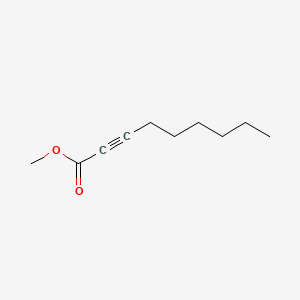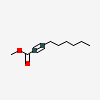Methyl 2-nonynoate
- Methyl 2-nonynoate
- Methyl non-2-ynoate
- 111-80-8
- Methyl octine carbonate
- 2-Nonynoic acid methyl ester
- Create:2005-03-26
- Modify:2025-01-18

- 2-nonynoic acid methyl ester
- methyl 2-nonynoate
- methyl octine carbonate
- Methyl 2-nonynoate
- Methyl non-2-ynoate
- 111-80-8
- Methyl octine carbonate
- 2-Nonynoic acid methyl ester
- 2-NONYNOIC ACID, METHYL ESTER
- Methyl octyne carbonate
- Methyloctyne carboxylate
- Methyloctyne carbonate
- Methyl octin carbonate
- Octynecarboxylic acid, methyl ester
- methyl octynecarboxylate
- FEMA No. 2726
- MFCD00009547
- 1-Octynecarboxylic acid, methyl ester
- 8RN66UR57V
- DTXSID3047639
- CHEBI:51749
- NSC-72102
- EINECS 203-909-2
- NSC 72102
- BRN 1759870
- UNII-8RN66UR57V
- methyl nonynoate
- AI3-35983
- METHYL OCTINECARBONATE
- WLN: 7UU1VO1
- SCHEMBL272763
- non-2-ynoic acid methyl ester
- CHEMBL3185173
- DTXCID1027639
- FEMA 2726
- Methyl 2-nonynoate, 99%, FG
- METHYL 2-NONYNOATE [FHFI]
- NSC72102
- Tox21_302446
- LMFA07010964
- AKOS015904010
- CS-W014298
- NCGC00256868-01
- AS-57232
- CAS-111-80-8
- SY049071
- DB-041006
- N0595
- NS00012949
- D91742
- Methyl 2-nonynoate, analytical reference material
- Q27122729
- Extracellular
- Membrane
Information on 16 consumer products that contain Methyl Octine Carbonate in the following categories is provided:
• Auto Products
• Inside the Home


H302 (99.6%): Harmful if swallowed [Warning Acute toxicity, oral]
H315 (74.9%): Causes skin irritation [Warning Skin corrosion/irritation]
H317 (97.9%): May cause an allergic skin reaction [Warning Sensitization, Skin]
H400 (75%): Very toxic to aquatic life [Warning Hazardous to the aquatic environment, acute hazard]
H412 (75%): Harmful to aquatic life with long lasting effects [Hazardous to the aquatic environment, long-term hazard]
P261, P264, P270, P272, P273, P280, P301+P317, P302+P352, P321, P330, P332+P317, P333+P317, P362+P364, P391, and P501
(The corresponding statement to each P-code can be found at the GHS Classification page.)
Aggregated GHS information provided per 1826 reports by companies from 12 notifications to the ECHA C&L Inventory. Each notification may be associated with multiple companies.
Information may vary between notifications depending on impurities, additives, and other factors. The percentage value in parenthesis indicates the notified classification ratio from companies that provide hazard codes. Only hazard codes with percentage values above 10% are shown.
Acute Tox. 4 (99.6%)
Skin Irrit. 2 (74.9%)
Skin Sens. 1A (97.9%)
Aquatic Acute 1 (75%)
Aquatic Chronic 3 (75%)
Patents are available for this chemical structure:
https://patentscope.wipo.int/search/en/result.jsf?inchikey=NTLJTUMJJWVCTL-UHFFFAOYSA-N
- Australian Industrial Chemicals Introduction Scheme (AICIS)2-Nonynoic acid, methyl esterhttps://services.industrialchemicals.gov.au/search-assessments/2-Nonynoic acid, methyl esterhttps://services.industrialchemicals.gov.au/search-inventory/
- CAS Common ChemistryLICENSEThe data from CAS Common Chemistry is provided under a CC-BY-NC 4.0 license, unless otherwise stated.https://creativecommons.org/licenses/by-nc/4.0/Methyl 2-nonynoatehttps://commonchemistry.cas.org/detail?cas_rn=111-80-8
- ChemIDplus2-Nonynoic acid methyl esterhttps://pubchem.ncbi.nlm.nih.gov/substance/?source=chemidplus&sourceid=0000111808ChemIDplus Chemical Information Classificationhttps://pubchem.ncbi.nlm.nih.gov/source/ChemIDplus
- DTP/NCILICENSEUnless otherwise indicated, all text within NCI products is free of copyright and may be reused without our permission. Credit the National Cancer Institute as the source.https://www.cancer.gov/policies/copyright-reuse
- EPA Chemicals under the TSCA2-Nonynoic acid, methyl esterhttps://www.epa.gov/chemicals-under-tscaEPA TSCA Classificationhttps://www.epa.gov/tsca-inventory
- EPA DSSToxMethyl 2-nonynoatehttps://comptox.epa.gov/dashboard/DTXSID3047639CompTox Chemicals Dashboard Chemical Listshttps://comptox.epa.gov/dashboard/chemical-lists/
- European Chemicals Agency (ECHA)LICENSEUse of the information, documents and data from the ECHA website is subject to the terms and conditions of this Legal Notice, and subject to other binding limitations provided for under applicable law, the information, documents and data made available on the ECHA website may be reproduced, distributed and/or used, totally or in part, for non-commercial purposes provided that ECHA is acknowledged as the source: "Source: European Chemicals Agency, http://echa.europa.eu/". Such acknowledgement must be included in each copy of the material. ECHA permits and encourages organisations and individuals to create links to the ECHA website under the following cumulative conditions: Links can only be made to webpages that provide a link to the Legal Notice page.https://echa.europa.eu/web/guest/legal-noticeMethyl non-2-ynoatehttps://chem.echa.europa.eu/100.003.554Methyl non-2-ynoate (EC: 203-909-2)https://echa.europa.eu/information-on-chemicals/cl-inventory-database/-/discli/details/131442
- FDA Global Substance Registration System (GSRS)LICENSEUnless otherwise noted, the contents of the FDA website (www.fda.gov), both text and graphics, are not copyrighted. They are in the public domain and may be republished, reprinted and otherwise used freely by anyone without the need to obtain permission from FDA. Credit to the U.S. Food and Drug Administration as the source is appreciated but not required.https://www.fda.gov/about-fda/about-website/website-policies#linkingMETHYL 2-NONYNOATEhttps://gsrs.ncats.nih.gov/ginas/app/beta/substances/8RN66UR57V
- Human Metabolome Database (HMDB)LICENSEHMDB is offered to the public as a freely available resource. Use and re-distribution of the data, in whole or in part, for commercial purposes requires explicit permission of the authors and explicit acknowledgment of the source material (HMDB) and the original publication (see the HMDB citing page). We ask that users who download significant portions of the database cite the HMDB paper in any resulting publications.http://www.hmdb.ca/citingMethyl octynecarboxylatehttp://www.hmdb.ca/metabolites/HMDB0031273
- International Fragrance Association (IFRA)LICENSE(c) The International Fragrance Association, 2007-2021. All rights reserved.https://ifrafragrance.org/links/copyrightMethyl 2-nonynoatehttps://ifrafragrance.org/priorities/ingredients/ifra-transparency-listMethyl octine carbonatehttps://ifrafragrance.org/standards/IFRA_STD_064.pdf
- New Zealand Environmental Protection Authority (EPA)LICENSEThis work is licensed under the Creative Commons Attribution-ShareAlike 4.0 International licence.https://www.epa.govt.nz/about-this-site/general-copyright-statement/
- ChEBIMethyl non-2-ynoatehttps://www.ebi.ac.uk/chebi/searchId.do?chebiId=CHEBI:51749
- LOTUS - the natural products occurrence databaseLICENSEThe code for LOTUS is released under the GNU General Public License v3.0.https://lotus.nprod.net/Methyl 2-nonynoatehttps://www.wikidata.org/wiki/Q27122729LOTUS Treehttps://lotus.naturalproducts.net/
- ChEMBLLICENSEAccess to the web interface of ChEMBL is made under the EBI's Terms of Use (http://www.ebi.ac.uk/Information/termsofuse.html). The ChEMBL data is made available on a Creative Commons Attribution-Share Alike 3.0 Unported License (http://creativecommons.org/licenses/by-sa/3.0/).http://www.ebi.ac.uk/Information/termsofuse.html
- Comparative Toxicogenomics Database (CTD)LICENSEIt is to be used only for research and educational purposes. Any reproduction or use for commercial purpose is prohibited without the prior express written permission of NC State University.http://ctdbase.org/about/legal.jsp2-nonynoic acid methyl esterhttps://ctdbase.org/detail.go?type=chem&acc=C055802
- Consumer Product Information Database (CPID)LICENSECopyright (c) 2024 DeLima Associates. All rights reserved. Unless otherwise indicated, all materials from CPID are copyrighted by DeLima Associates. No part of these materials, either text or image may be used for any purpose other than for personal use. Therefore, reproduction, modification, storage in a retrieval system or retransmission, in any form or by any means, electronic, mechanical or otherwise, for reasons other than personal use, is strictly prohibited without prior written permission.https://www.whatsinproducts.com/contents/view/1/6Methyl Octine Carbonatehttps://www.whatsinproducts.com/chemicals/view/1/5556/000111-80-8Consumer Products Category Classificationhttps://www.whatsinproducts.com/
- EPA Chemical and Products Database (CPDat)EPA CPDat Classificationhttps://www.epa.gov/chemical-research/chemical-and-products-database-cpdat
- EU Food Improvement AgentsMethyl 2-nonynoatehttps://eur-lex.europa.eu/legal-content/EN/TXT/?uri=CELEX:32012R0872
- Joint FAO/WHO Expert Committee on Food Additives (JECFA)LICENSEPermission from WHO is not required for the use of WHO materials issued under the Creative Commons Attribution-NonCommercial-ShareAlike 3.0 Intergovernmental Organization (CC BY-NC-SA 3.0 IGO) licence.https://www.who.int/about/policies/publishing/copyrightMETHYL 2-NONYNOATEhttps://apps.who.int/food-additives-contaminants-jecfa-database/Home/Chemical/5048Methyl 2-nonynoatehttps://www.fao.org/food/food-safety-quality/scientific-advice/jecfa/jecfa-flav/details/en/c/1355/METHYL OCTINE CARBONATEhttps://apps.who.int/food-additives-contaminants-jecfa-database/Home/Chemical/5049
- Hazardous Chemical Information System (HCIS), Safe Work Australia
- FDA Substances Added to FoodLICENSEUnless otherwise noted, the contents of the FDA website (www.fda.gov), both text and graphics, are not copyrighted. They are in the public domain and may be republished, reprinted and otherwise used freely by anyone without the need to obtain permission from FDA. Credit to the U.S. Food and Drug Administration as the source is appreciated but not required.https://www.fda.gov/about-fda/about-website/website-policies#linking
- Flavor and Extract Manufacturers Association (FEMA)METHYL 2-NONYNOATEhttps://www.femaflavor.org/flavor-library/methyl-2-nonynoate
- Japan Chemical Substance Dictionary (Nikkaji)
- KNApSAcK Species-Metabolite Database
- LIPID MAPSLipid Classificationhttps://www.lipidmaps.org/
- Metabolomics WorkbenchMethyl octynecarboxylatehttps://www.metabolomicsworkbench.org/data/StructureData.php?RegNo=44793
- Nature Chemistry
- NIST Mass Spectrometry Data CenterLICENSEData covered by the Standard Reference Data Act of 1968 as amended.https://www.nist.gov/srd/public-law2-Nonynoic acid, methyl esterhttp://www.nist.gov/srd/nist1a.cfm
- SpectraBaseMethyl octine carbonatehttps://spectrabase.com/spectrum/HHGpL5v0J3hNon-2-ynoate <methyl->https://spectrabase.com/spectrum/6xTGjnw5lWnMETHYL 2-NONYNOATEhttps://spectrabase.com/spectrum/825u6XQIiNJ2-NONYNOIC ACID, METHYL ESTERhttps://spectrabase.com/spectrum/FR11GBNLhc42-NONYNOIC ACID, METHYL ESTERhttps://spectrabase.com/spectrum/H0MSjcQ9CWm2-Nonynoic acid, methyl esterhttps://spectrabase.com/spectrum/BBJYGKqm85B2-nonynoic acid, methyl esterhttps://spectrabase.com/spectrum/EQzc1x9KxYuMethyl 2-nonynoatehttps://spectrabase.com/spectrum/5SK8m0nekXP2-NONYNOIC ACID, METHYL ESTERhttps://spectrabase.com/spectrum/HCP0aOtlMfpMETHYL 2-NONYNOATE, 99%https://spectrabase.com/spectrum/1HjSCnQP4xoMethyl 2-nonynoatehttps://spectrabase.com/spectrum/IzmuXJwPsFW
- Springer Nature
- Thieme ChemistryLICENSEThe Thieme Chemistry contribution within PubChem is provided under a CC-BY-NC-ND 4.0 license, unless otherwise stated.https://creativecommons.org/licenses/by-nc-nd/4.0/
- Wikidatamethyl 2-nonynoatehttps://www.wikidata.org/wiki/Q27122729
- PubChem
- Medical Subject Headings (MeSH)LICENSEWorks produced by the U.S. government are not subject to copyright protection in the United States. Any such works found on National Library of Medicine (NLM) Web sites may be freely used or reproduced without permission in the U.S.https://www.nlm.nih.gov/copyright.html2-nonynoic acid methyl esterhttps://www.ncbi.nlm.nih.gov/mesh/67055802
- GHS Classification (UNECE)GHS Classification Treehttp://www.unece.org/trans/danger/publi/ghs/ghs_welcome_e.html
- NORMAN Suspect List ExchangeLICENSEData: CC-BY 4.0; Code (hosted by ECI, LCSB): Artistic-2.0https://creativecommons.org/licenses/by/4.0/NORMAN Suspect List Exchange Classificationhttps://www.norman-network.com/nds/SLE/
- EPA Substance Registry ServicesEPA SRS List Classificationhttps://sor.epa.gov/sor_internet/registry/substreg/LandingPage.do
- MolGenieMolGenie Organic Chemistry Ontologyhttps://github.com/MolGenie/ontology/
- PATENTSCOPE (WIPO)SID 403385960https://pubchem.ncbi.nlm.nih.gov/substance/403385960

